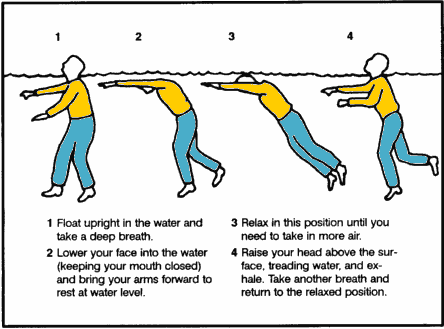Drownproofing Sequence
Drownproofing is actually really fun. Using the natural buoyancy of the human body when the lungs are filled with air saves energy. It is much easier to do than stay afloat by swimming.
Use waterproof clothes to begin with. They trap some air for extra buoyancy, as shown on photos below. Other clothing might work, but air may leak faster.
This sequence should not be used in cold water as you'd lose too much heat. It needs a bit of practice but may come in handy in an emergency. It builds confidence and specific skills to survive longer.

While most people can master drownproofing easily,
some skill is involved in breathing close to the water.
Once you master this sequence, you will have control of yourself in the water.
You will realize how buoyant you are with your lungs fully inflated and your body relaxed.
Resting or Starting Position
Take a deep breath and then sink below the surface.
Hold your breath, and put the face in the water.
Keep the face down with the back of the head even with the water surface.
Let the arms and legs dangle, you will sink no deeper.
Any trapped air gives you extra buoyancy.
Prepare to Exhale
When ready for another breath (in about 6 to 10 seconds), maintaining the body and head position,
slowly lift the arms to about shoulder height.
The legs slowly separate into a scissors-type kick,
or do a bicycle-like movement with the legs.
Exhale and Inhale
Raise your head just high enough for your mouth to be out of the water.
Exhale through the nose, the mouth, or both.
To keep your bearing, your eyes should be open.
Now take another deep breath.
Inhale through the mouth and slowly return to the resting/starting position.
Return to Resting Position
Now relax your arms and move your legs back to a dangling position.
Your face goes back into the water and you "rest" once again.
The cycle is then repeated.